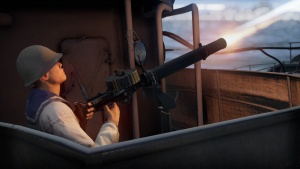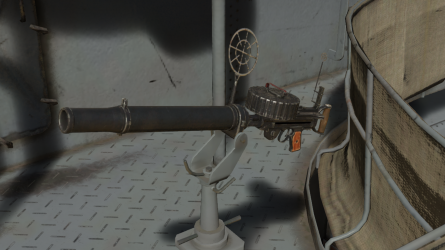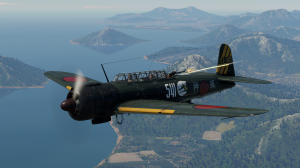Type 92 (7.7 mm)
Contents
Description
Write an introduction to the article in 2-3 small paragraphs. Briefly tell us about the history of the development and combat using the weaponry and also about its features. Compile a list of air, ground, or naval vehicles that feature this weapon system in the game.
Vehicles equipped with this weapon
| Vehicles equipped with this weapon | |
|---|---|
| Bombers | B5N2 (Defensive) · B6N1 Model 11 (Defensive) · B6N2 Model 12 (Defensive) · D3A1 (Defensive) · D4Y1 (Defensive) · D4Y2 (Defensive) |
| G4M1 (Defensive) · H6K4 (Defensive) · H8K2 (Defensive) · H8K3 (Defensive) | |
| Motor torpedo boats | Type T-1 |
| Destroyers | IJN Mutsuki · IJN Satsuki |
| Light cruisers | IJN Tama · IJN Sendai |
General info

The Type 92 is the IJN's standard defensive 7.92 mm machine gun. It is found on many bombers as defensive turrets, and on certain ships as well. It is characterized as being one of the worst machine guns in the game, with a low rate of fire (600 RPM) and bad ballistics, as well as poor accuracy, it is not too good at doing its job. However, on lower tier dive bombers like the D3A1, this gun can work wonders. If shot into the engine of an aircraft, it will most likely start a fire, and it is very common for this to happen. The Incendiary power of the belts is often underestimated!
Available ammunition
Default: T/AP/Ball/AP/IAI/I - Great belt for setting fires when shot into the engine of an aircraft
Armored Targets: T/AP/AP/IAI/AP - Mediocre belt with AP shells to smash through bulletproof glass
AP-T: T/AP/T/AP - Great belt for scare tactics, use the tracers to scare off the enemy. (The more tracers they see, the more they think of Danger and Retreat!)
Comparison with analogues
Give a comparative description of cannons/machine guns that have firepower equal to this weapon.
Usage in battles
The Type 92 should be used against fighters in only the most die circumstances. All Japanese planes can out maneuver any pursuing fighter, or if the enemy is a biplane, outrun them. This turret is a LAST RESORT when facing enemy fighters. it has a low rate of fire and can barely damage an enemy. The type 92 can actually find good use when ground pounding. You can point the tail down at the ground and fire the Type 92 at soft ground targets.
Pros and cons
Pros:
- High incendiary potential
- Capable of scaring off unsuspecting fighters
Cons:
- Poor Ballistics
- Jams Quickly
- Inaccurate
- Slow Rate of Fire
History
It was the standard hand-held machine gun in multi-place IJN aircraft during the most part of the Pacific War. It proved to be seriously inadequate. Aircraft produced in the later part of the conflict often were equipped with weapons such as Type 1 and Type 2 machine guns or Type 99 cannon.
Essentially a copy of the shroudless post-World War I aircraft-mounted version of the British Lewis gun, the Type 92 was fed with a 97-round drum magazine and used on a flexible mount. It was chambered in a Japanese copy of the .303 British cartridge. The main external difference between the two models was the trigger guard, and cooling fins around the barrel and gas piston tube. Neither the post-World War I British aircraft Lewis nor the Japanese copy featured the distinctive thick barrel shroud of the original gun (although ground-based versions generally retained it). It was removed as it was found that the airflow past the aircraft was sufficient for cooling the barrel and eliminating the shroud reduced the mass.
Media
See also
Links to the articles on the War Thunder Wiki that you think will be useful for the reader, for example:
- reference to the article about the variant of the cannon/machine gun;
- references to approximate analogues by other nations and research trees.
External links
Paste links to sources and external resources, such as:
- topic on the official game forum;
- encyclopedia page on the weapon;
- other literature.
| Aircraft machine guns | |
|---|---|
| USA | |
| 7.62 mm | Browning · M134 Minigun |
| 12.7 mm | GAU-19 · M2 Browning · M3 Browning |
| Germany | |
| 7.62 mm | MG3 |
| 7.92 mm | MG 15 · MG 17 · MG 81 |
| 12.7 mm | FN M3P |
| 13 mm | MG 131 |
| USSR | |
| 7.62 mm | DA · GShG-7.62 · PKT · PV-1 · ShKAS |
| 12.7 mm | A-12.7 · Berezin UB · TKB-481 · YaK-B |
| Britain | |
| 7.62 mm | FN 60.30 · L8A1 |
| 7.7 mm | Browning · Lewis · Vickers E · Vickers K |
| Japan | |
| 7.7 mm | Te-1 · Type 89 · Type 89 'special' · Type 92 · Type 97 navy |
| 7.92 mm | Type 1 · Type 98 |
| 12.7 mm | Ho-103 · Ho-104 |
| 13 mm | Type 2 |
| 13.2 mm | Type 3 |
| China | |
| 12.7 mm | QJK99-12.7-1 |
| Italy | |
| 7.7 mm | Breda-SAFAT · Lewis |
| 7.92 mm | FN Browning |
| 12.7 mm | Breda-SAFAT · FN M3M · Scotti |
| France | |
| 7.5 mm | Darne 1933 · Fabrique Nationale Mle 38 · FN Browning · MAC 1934 · MAC 1934T · Mle 33 · Mle 1923 |
| 7.62 mm | PKA |
| 7.92 mm | FN-Browning M.36 No.3 · FN-Browning M.36 No.4 |
| Sweden | |
| 7.7 mm | FN-Browning M.36 No.3 |
| 8 mm | Ksp m/22 · Ksp m/22 Fh · Ksp m/22 Fv · Ksp m/22-37 R |
| 12.7 mm | Akan m/39A · Akan m/40 · Akan m/45 · LKk/42 |
| 13.2 mm | Akan m/39 · Akan m/39A |
| Naval machine guns | |
|---|---|
| USA | |
| 7.62 mm | M73 |
| 12.7 mm | AN-M2 |
| Germany | |
| 7.62 mm | MG-3 |
| 7.92 mm | MG08 pattern 1908 · MG15 · MG34 |
| 13.2 mm | Hotchkiss |
| 15 mm | MG M38(t) |
| USSR | |
| 7.62 mm | Maxim |
| 12.7 mm | DShK |
| 14.5 mm | KPV |
| Britain | |
| 7.62 mm | FN MAG |
| 7.7 mm | Lewis 1916 · Vickers GO No.5 |
| 12.7 mm | Vickers Mk.V |
| Japan | |
| 6.5 mm | Maxim · Type 38 pattern 1907 |
| 7.7 mm | Type 89 · Type 92 |
| 13.2 mm | Type 93 |
| Italy | |
| 6.5 mm | Breda Mod.30 · Fiat Model 26 |
| 12.7 mm | Breda-SAFAT |
| 13.2 mm | Breda Model 31 |
| France | |
| 7.7 mm | Darne M1922 |
| 7.92 mm | Hotchkiss pattern 1914 |
| 13.2 mm | Browning · Model 1929 Hotchkiss |





